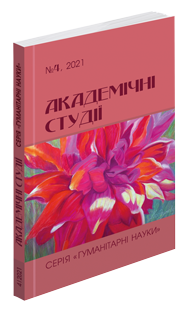Abstract
The article is devoted to the conclusion of the typology of images that served as the basis internal forms of German obscene phraseology, which verbalize stereotypes. Determining the types of images of the internal form is carried out in the focus of onomasiological approach, the essence of which, within the proposed intelligence, we see in the identification of extralingual factors of the origin of the image of the object extralinguistic reality, the isolation of its features through the prism of the national culture, the use of stereotyped features as the basis of phraseology semiosis. The content of the image of the internal form is considered crucial for the result of the formation of phraseological meaning. It turns out that the system images, on the basis of which obscene PU are formed, is based on fragments value picture of the world. Within the value picture of the world is clearly manifested a continuum of anti-values that are semantized in obscene phraseology.
The image underlying the internal form of phraseology is not realizes all its features simultaneously. For the process of phrase formation the feature of the extralingual image which promotes formation is also used appropriate language image, its linguistic. Symptoms are not activate dimplicitly present in the structure of phraseological meaning, influencing formation of connotation components, realizing own semantic implications.
Stereotyped signs of the image of the internal form can be detected during the reconstruction of the onomasiological basis, or because of quasi-visual representation of the image due to transparent linguistic visualization of the signs that served basis of phrase formation. Reconstruction of the onomasiological basis is carried out by tracking associative connections.
As a result of onomasiological analysis of the process of semiosis of the obscene phraseology, given the epistemological approach, proposed a typology images based on: mode of origin, sources of origin, forms of expression obscene value in the structure of the studied units. As the forms of expressions we understand token lexemes in the structure of phraseology. It has been found that a number of such token lexemes are formed because of combination components of nominative structures of stereotyped images of different types.
References
ВУЕ: Велика українська енциклопедія. Духовні цінності. URL: https://vue.gov.ua (дата звернення: 20.01.2022).
Грайс Г. П. Логика и речевое общение. Новое в зарубежной лингвистике. Лингвистическая прагматика / под ред. Е. В. Падучевой. Москва : Прогресс, 1985. Вып.16. С. 217–237. URL: http://kant.narod.ru/grice. htm (дата звернення: 20.01.2022).
Добровольский Д. О. Образная составляющая в семантике идиом. Вопросы языкознания. 1996. № 1. С. 71–93. URL: https://vja.ruslang.ru/ru/archive/1996-1/71-93 (дата звернення: 20.01.2022).
Жуйкова М. Образна основа фразеологічних одиниць та проблема їх мовнокультурної реконструкції. Humanity, computers and communication. (Lviv. Ukraine, 22-24 april 2015). Львів, 2015. С. 157–161.
Матюк. Словарь української мови : у 4 т./ ред. Б. Грінченка. Київ : Кіевская старина, 1907–1909. URL: http://ukrlit.org/slovnyk/hrinchenko_slovar_ukrainskoi_movy (дата звернення: 20.01.2022).
Ненормативна лексика як приносила всесвітню популярність, так і приводила на лаву підсудних. Weekend. 30.09-06.10.2006. URL: https://zib.com.ua/ua/ 2671.html (дата звернення: 17.01.2022).
НЛ: Ненормативна лексика. URL: https://uk.wikipedia.org/ (дата звернення: 17.01.2022).
Словник.ua. Портал української мови і культури. URL: https://slovnyk.ua/index.php?swrd=%D0%BC%D0%B0 (дата звернення: 13.01.2022).
СУМ: Словник української мови. Академічний тлумачний словник (1970–1980). URL: http://sum.in.ua/s/zloslovyty (дата звернення: 10.01.2022).
Угринюк В. М. Типологія вмотивованості фразеологічних одиниць сучасної німецької мови (кількісні та якісні характеристики) : автореф. дис. … канд. філол. наук : 10.02.04. Київ, 1993. URL: https://cheloveknauka.com/v/540889/ a#?page=18 (дата звернення: 12.01.2022).
УОЛ: Українська обсценна лексика: фольклор, література і сучасність. URL: http://kherson.fm/2020/11 (дата звернення: 12.01.2022).
Ференц Н. Основи літературознавства. Київ : Знання, 2011. URL: https://ukrlit.net/info/literary_1 /35.html (дата звернення: 05.01.2022).
Челеби Эвлия. Книга путешествий Сейахатнаме. Земли Молдавии и Украины. Том V. URL: https://www.vostlit.info/Texts/rus8/Celebi3/text5.phtml?id=1731 (дата звернення: 02.01.2022).
ЯН: Языковая номинация (Общие вопросы) / редкол. : А. А. Уфимцева и др. ; (под ред.) Б. А. Серебренникова, А. А. Уфимцевой. Москва : Наука, 1977. 360 с.
Drößiger Hans-Harry. Schimpfwörter und Beschimpfungen. Man and the Word. Foreign Languages. Thesen zur Terminologie und zum Forschungsstand in der Sprachforschung. 2017. Т. 19. Nr. 3. P. 23–37.
Duden. URL: https://www.duden.de (дата звернення: 15.01.2022).
DW: Deutsches Wörterbuch von Jacob Grimm und Wilhelm Grimm. URL: https://sternenvogelreisen.de/schimpfwoerter-grimm-woerterbuch/ (дата звернення: 15.01.2022).
WRRiASWUS: Wörterbuch für Redensarten, Redewendungen, idiomatische Ausdrücke, Sprichwörter, Umgangssprache. URL: https://www.redensarten-index.de (дата звернення: 15.01.2022).

